Meiji Jingu is one of the most famous and important shrines in Tokyo, as well as one of the most-visited. The shrine’s Inner Gardens, however, are an often overlooked feature to the beautiful shrine grounds, and are worthy of a visit.
The gardens cover over 83,000 square meters of land between the main shrine buildings and Yoyogi Park. For a 500 yen entrance fee, visitors can enter the garden and stroll on the stone pathways leading through scenic forests. There is a quaint tea house constructed in traditional Japanese style. There is also a large iris garden, which is at its most beautiful in June when the flowers are in full bloom. At the center of the garden is the South Pond, a quiet body of water filled with turtles and colorful koi.
Another popular feature of the garden is Kiyomasa’s Well. The well is at the mouth of the stream that runs to the South Pond. This spot has become popular due to its designation as a “power spot,” or a place said to give off positive, restorative, and lucky energies to people who visit it. These days, due to the increased popularity of the “power spot” fad, a special security guard is usually stationed at the well to maintain the line of visitors and ensure that each person doesn’t take too long in their admiration and photo-taking.
The Inner Gardens were initially part of the residence of Kiyomasa Kato, a powerful political and military figure in Japanese history during the 1500’s and 1600’s. Though his family owned the land, it is uncertain whether Kato ever resided there himself. During the Meiji Period (late 1800’s-early 1900’s) the gardens were taken under control of the Japanese government and named Yoyogi Gyoen (Yoyogi Imperial Gardens). The Meiji Emperor and Empress were frequent visitors. Today, the Inner Gardens are also known as Meiji Jingu Gyoen.
The Meiji Jingu Shrine is a 1 minute walk from the Omotesando Exit of Harajuku Station (JR Yamanote Line), or the JR Exit of Meiji Jingu Mae Station (Chiyoda and Fukutoshin Lines). After passing beneath the large entrance torii gate, visitors will walk down a forested path towards the shrine. The entrance to the Inner Gardens is off the path, to the left, and they are open from 9am-4:30pm between March and October, and 9am-5pm from November to February. In June, the hours are 8am-5pm during the week and 8am-6pm on Saturdays and Sundays to accommodate the people blooming of the irises.
_________________________________________________________________________________
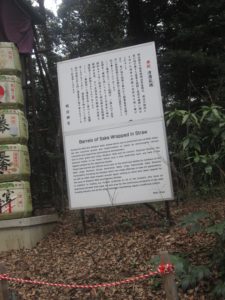
… Barrels of Sake Wrapped in Straw ….
From the website The Japan Times News
Those are indeed sake barrels, but as their name reveals, they are not full of rice wine. When displayed near a Shinto shrine, such barrels are called kazaridaru, which means “decoration barrels.” As you surmised, the barrels on display are empty, at least in physical terms. Spiritually, they’re chock full of significance.
“In Japan, sake has always been a way of bringing our gods and people together,” Tetsuo Hasuo of the Japan Sake Brewers Association explained when I brought your question to him. “In some of this country’s oldest texts the word used for sake is miki, written with the characters for ‘god’ and ‘wine.’ People would go a shrine festival and be given rice wine to drink, and they would feel happy and closer to the gods.”
These days, the word miki (or o-miki when given its honorific prefix) is reserved for rice wine used in Shinto rites and festivals. Sipping a cup is still a prayerful act of symbolic unification with the gods. Shinto shrines and sake manufacturers maintain a symbiotic relationship, in which the shrines conduct rites to ask the gods for the prosperity of the brewers, and — this is where the barrels come in — the brewers donate the grog that shrines need for ceremonies and festivals. There is no particular season for donations, according to Hasuo.
“Shrines need more sake when they have festivals, the timing of which varies by shrine,” he said. “But festivals are most often held in the spring and fall, so those are the busiest season for donations.”
Smaller shrines usually get their o-miki from local sake companies, but two shrines, Meiji Jingu in Tokyo and Ise Jingu in Mie Prefecture, look after the entire national product by accepting donations from every rice-wine brewer in the country.
Given that there are about 1,800 sake manufacturers in Japan, that’s quite an undertaking. The logistics are handled by a special committee at each shrine called the shuzokeishinkai (brewer reverence committee), which works out who sends what.
When it comes to barrels, the committee will ask for only as many full ones as the shrine actually needs for festivals and ceremonies.
“Generally, a brewer provides just one bottle, or an empty barrel for display. It’s the kimochi (gesture) that’s important,” Hasuo said, “because asking for or giving more sake than is actually needed would be mottainai (wasteful).”
This strikes me as an example of traditional Japanese values: Shinto gods don’t make unreasonable demands of people, and people show respect for the natural world inhabited by Shinto gods by avoiding waste.
At many shrines, including Meiji Jingu, empty barrels received as donations are stacked and bound together, then fixed with rope to a simple frame to keep them from falling over.
Other shrines, including the Hachiman Shrine in Kamakura, have a permanent wooden structure that looks like a gigantic bookcase on which the barrels are neatly shelved. Smaller shrines line up their casks on a dais or simply display them wherever it’s convenient.
A few shrines don’t have to rely on donations to get their o-miki because they brew their own. The number of shrines doing so, however, is extremely limited. Rice-wine production has been regulated in Japan since the eighth century and even shrines making sake for onsite consumption are required to have a government license. This is true for individuals too, which is why you don’t hear about home sake brewing as a hobby in Japan.
In any case, there are only four shrines in all of Japan licensed to make sake. One of them, Okazaki Hachiman Shrine in Yamaguchi Prefecture, makes an unusual white sake called shiroki that can be sampled during the shrine’s fall festival, held on the third Saturday in October. Another 40 shrines are licensed to make an unrefined rice wine called doburoku, also served at festivals.
Rice wine is not normally stored in barrels because it picks up too much of the taste and smell of the wood. But a short stay gives the sake a pleasant woody aroma, so upon request brewers fill barrels (from a steel tank) a few days in advance of festivals and other special occasions.
You don’t have to be connected with a shrine to get your hands on one of those sake barrels, which are called komodaru. (Komo is the woven straw wrapped around the staves.) You can buy an empty barrel if you really want to, or you can order a full one for a wedding or party. A standard komodaru holds four to (an old measure), or 72 liters, and will set you back about ¥100,000. If that’s too much sake for your party but you still want the impact of a big barrel, you can request an agezoku (false bottom) that reduces the fill to as little as one to (18 liters).
It’s a custom at New Year’s parties, weddings and consecrations of new buildings to break open a barrel of sake in a ceremony called kagamibiraki. Kagami usually means “mirror,” but in this case it refers to the wooden lid on the top of the barrel. A favored few are armed with wooden mallets, and after appropriate wishes for health, happiness and prosperity, the hammer holders give a cry and smash open the top of the barrel. Cups of the sake are distributed to all and a toast is made.
And after that? Well, there’s really only one thing to do: try to get to the bottom of the barrel!0
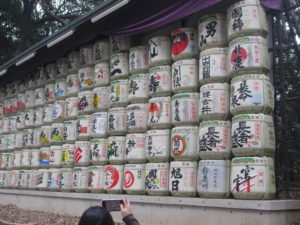

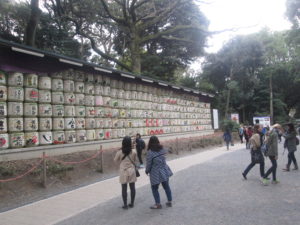

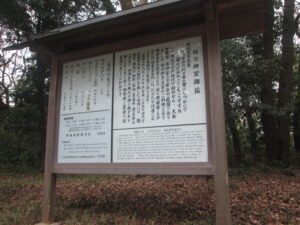
The sign above says: THE GRAND SHRINE GATE
This is the biggest wooden ‘torrii’ of the myojin style in Japan. Rebuilt and dedicated by a pious benefactor on December 23 1975 and modelled both in form ands size exactly after the original built in 1920. The material wood used is ‘Hinoi’ (Japanese cypress), 1500 years old from Mt. Tandai, Taiwan.
Height = 12 m (metres) Length of crosspiece = 17.0 m
Diameter of each pillar = 1.2 m Length of under crosspiece = 15.5 m
Distance between the two pillars=9.1m
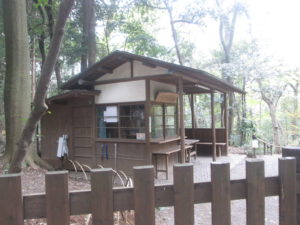
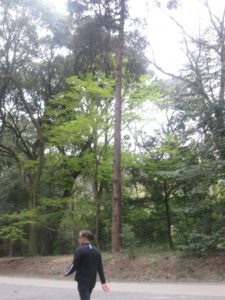
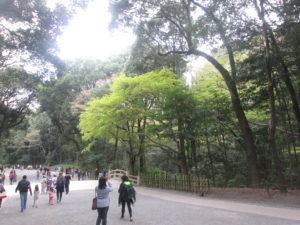
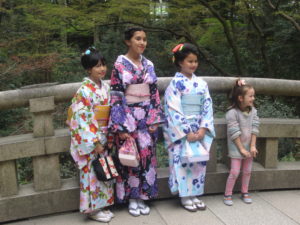
…. A Japanese women with her three girls …. dressed in eye catching Kimono dresses. See the display of Kimono dresses we saw being demonstrated later in our trip:
POST 11c: OUR HOLIDAY IN JAPAN …. Kimonos Display with models …. Day 11 of 16: 14th April, 2017
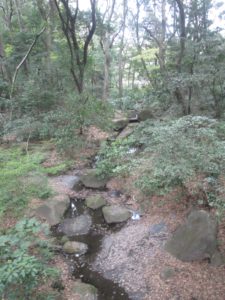
___________________________________________________________________________________________
